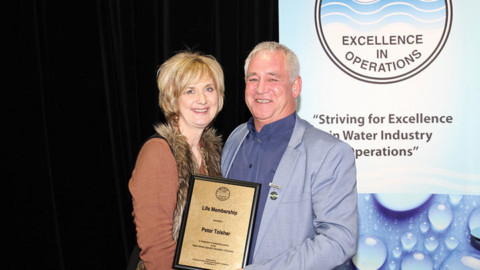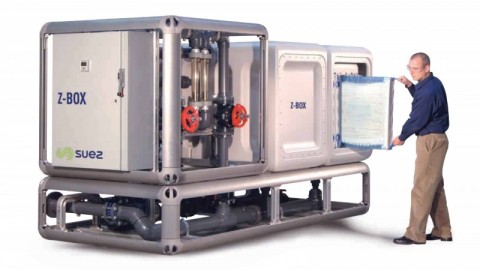The rapid evolution and maturity of smart and digital technologies is creating diverse opportunities for utilities to adopt emerging devices and systems which improve operational efficiency, customer experience and enable greater safety outcomes.
With a long history of innovation, SA Water is embracing change by fostering and developing new applications of technology for the benefit of its customers and communities.
The South Australian utility’s smart network is leading the way by integrating digital and smart technologies to enhance traditional asset management and deliver real-time monitoring and predictive analytics of its underground network of water and sewer mains.
Listening to the sounds of the water network
In 2017, SA Water deployed the first iteration of its smart network in Adelaide’s CBD. The idea behind the initiative was conceptualised by the organisation’s own people, born out of a desire to improve customer experience and minimise community disruption.
Adelaide’s CBD water main network was selected for the initial rollout because of the higher potential for impact from main breaks and leaks due to the number of customers, including many water-dependent businesses and consistently busy traffic areas.
Harnessing technology from the ‘Internet of Things’, SA Water installed more than 300 smart sensors which included acoustic, transient pressure, flow and water quality sensors, tuning into the ‘music’ of water mains to monitor performance and detect potential leaks.
The sensors are integrated with an advanced data and analytics visualisation platform, and transmit data in real time to SA Water’s Operations Control Centre.
SA Water’s Senior Manager of Asset Management, Peter Seltsikas, said the corporation’s pioneering use of technology is delivering smarter water services that better meet customers’ expectations and needs.
“The advancement and agility of technology is enabling utilities to develop fresh approaches to managing underground infrastructure, and we want to ensure we’re at the forefront of the water industry for the benefit of our customers and communities,” Mr Seltsikas said.
“We are one of the first water utilities in the world to implement a range of complex smart sensors at scale in a defined geographical area, forging a new path for asset management.
“By analysing the data generated by our sensors, we can pinpoint network abnormalities and identify what might be the start of a leak or break, and fix them before they escalate and impact customer supply or cause disruption to road users.
“Our smart network has helped detect around half of all water main leaks and breaks in the Adelaide CBD since 2017, enabling our crews to proactively repair pipes while the city sleeps, with reduced water loss, customer supply interruptions and commuter delays.
“Innovative solutions like this are improving what we do and how we do it, providing a deeper understanding of our water network which ultimately refines our future planning and investment decisions.”
Embedding an advanced asset management strategy
Buoyed by the success of its Adelaide CBD smart network, SA Water expanded its advanced technology across the metropolitan area and regional centres in 2018 – while also adapting the initiative to its wastewater network.
An analysis of the utility’s network identified water infrastructure in four areas appropriate for the expansion, which included Athelstone, North Adelaide, Penneshaw and Port Lincoln.
The sewers of Gawler and Stonyfell were the debutants for SA Water’s smart technology, complementing existing ongoing maintenance programs.
In total, 88 level sensors, 88 odour detection sensors and eleven weather stations were installed between the two suburbs, helping monitor the movement of sewage and detect pipe blockages to prevent overflows and improve odour management.
Mr Seltsikas said the expansion across the state was yielding similar success and helped instill a new approach to asset management.
“With our smart network proving its worth and the architecture in place within the Adelaide CBD, we were inspired to take this blueprint and roll it out on a wider scale,” Mr Seltsikas said.
“We’ve now tailored the capability for a range of water and wastewater network performance indicators, providing real-time monitoring to enable predictive event detection and a deeper understanding of our infrastructure.
“The type of technology we deployed at each location differed, depending on the issue we are trying to address. Athelstone for example, has a relatively high rate of water main failures – the pipes move a lot due to some of the most reactive clay soils in Adelaide and there is high supply pressure as a result of the area’s topography.
“To help combat this, we installed a pressure modulating control station, as well as sensors to monitor the pressure and sound activity within the network, helping our teams use the control station to remotely measure and maintain a stable water pressure in the network at varying periods of demand through the day.
“Our smart network’s footprint and technological capacity has expanded significantly since its inception and the pace of maturity across our business is underpinning our transformation of asset management.
“Often understated, the invaluable data collected by the sensors and analysed by our team creates new insights that support asset planning and continuous innovation.”

The sensors are integrated with an advanced data and analytics visualisation platform and transmit data in real time to Sa Water’s operations control centre.
Sydneysiders seek smart sensor success
SA Water’s world-leading smart network technology and expertise recently played a key role in a national university and water industry collaboration in Sydney, aimed at tackling the global challenge of predicting leaks and breaks in large-scale water networks through emerging technology.
A vital component of SA Water’s pioneering smart network, 40 acoustic sensors were deployed within Sydney Water’s CBD water main network in late 2019 to provide advanced leak detection and enable data analytics.
During the trial period, around 20 hidden leaks and breaks were detected by the sensors and discovered through SA Water’s intricate analysis.
Mr Seltsikas said ongoing interest from peers and numerous industry accolades affirmed the corporation’s revolutionary application of technology.
“It is important that we share the knowledge we have built with the wider industry as well as continuing to improve our own network management practices,” Mr Seltsikas said.
“We have formed an excellent relationship with Sydney Water over the years, and the opportunity to pass on our experience and explore other emerging areas of leak detection technology will advance our knowledge and ensure Australia’s water industry remains a driving force of innovation.
“In only a few months, our partnership enabled their crews to proactively repair 20 leaks and breaks in the Sydney CBD network which could have resulted in greater disruption to the community.
“Water main leaks and breaks are not unique to any state or utility. Maintaining an underground network presents operational challenges which are compounded by environmental factors such as rainfall and soil conditions, and it’s difficult to predict when and where a fault might occur.
“By combining technology, innovation and capital investment, we’re demonstrating how utilities can create a positive impact on their network performance and customer experience.”
The acoustic sensors – which detect high-pitched frequencies generated by water escaping a pipe – have been monitoring an area of around 13km in the busy Sydney CBD.
As part of the $3 million project, which is coordinated by a New South Wales State Government initiative, the NSW Smart Sensing Network, several leading research universities and water utilities led a series of five sub-projects focused on applications of smart sensing technology to reduce pipe leaks and breaks.
SA Water’s integration of digital and smart technology for the benefit of its customers has seen it take out multiple national and international awards, prompting interest and knowledge sharing with countless utilities within Australia and from countries such as New Zealand, Japan and the US.
Looking to the future
With their investment in the technology to date totalling $13 million, SA Water has set aside further funds to expand its smart network further over the next four years.
Beyond the architecture and devices, its augmentation of the smart network continues to evolve and the recent creation of an in-house machine learning software platform for the acoustic detection of pipe breaks and wastewater blockages is asserting SA Water’s position at the forefront of smart utility transformation.
The utility has established its own Data Science team and in collaboration with the University of Adelaide, applied universal machine learning principles to historical data collected by the acoustic and level sensors – enabling the development of pattern learning and classification algorithms for proactive event detection.
“Our team’s working tirelessly to enhance our smart network capability and our thirst for innovation has seen us reach new heights,” Mr Seltsikas said.
“By designing a platform that can think for itself and predict potential failures, we’re even more prepared to leap into action and fix a leak or prevent an overflow before it can impact our customers or the community.
“Together with the University of Adelaide, we analysed relevant scientific methods and the behaviour of acoustic waves in relation to water main failures in the Adelaide CBD and changes in flows and depth patterns relevant to wastewater overflows in Stonyfell.
“Data from over 250,000 acoustic recordings from the Adelaide CBD were used to identify features and patterns in pipe break and environmental noise signatures, helping us develop specific algorithms that could single out the relevant sound of water escaping a pipe – which previously was a manual task.
“The success of our smart network is underpinned by our people and they continue to push the boundaries of conventional thinking and technology to deliver better services for customers.
“It’s important to note that our work with the smart network is not done alone – along with the University of Adelaide, we work with numerous utilities, industry bodies and specialised vendors from around Australia to find the best solutions and ensure we keep up-to-date with the latest technology and capabilities.”















